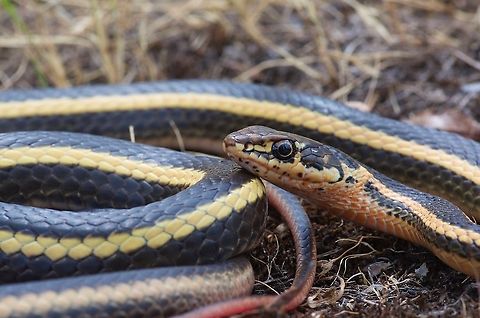
Appearance
''Masticophis lateralis'' is 90–120 centimetres in total length. It is slender, with a yellowish stripe along each side, set against a dark brown or black back.Naming
''Masticophis lateralis'' has two subspecies:⤷ ''M. l. lateralis'' — chaparral whipsnake
The chaparral whipsnake is a common subspecies in California and northern Baja California, Mexico. The subspecies is often associated with broken habitat types that range from northwestern to extreme southern California and further south into Northwestern Mexico.
⤷ ''M. l. euryxanthus'' Riemer, 1954 — Alameda whipsnake
The Alameda whipsnake subspecies is endemic to California. The subspecies is considered threatened there. Its range is relatively small, and much of the subspecies' habitat is threatened by development. It was first collected by Archie Mossman and later described by Riemer in 1954. The Alameda Whipsnake is a threatened species of colubrid snake distinguishable by its broad head, large eyes, black and orange coloring with a yellow stripe down each side, and a slender neck. The Alameda Whipsnake is a wary creature known for its speed and climbing abilities utilized when escaping predators or hunting prey.
''Nota bene'': A trinomial authority in parentheses indicates that the subspecies was originally described in a genus other than ''Masticophis''.
Behavior
''Masticophis lateralis'' is fast-moving, diurnal, and an active forager. It commonly moves over and through brush and trees to avoid predation and to capture prey. The California whipsnake has been observed moving into the top of scrub plants after emerging from nightly retreats to gain access to direct sunlight before the sunlight reaches ground level. It is not venomous, but likely to strike if captured.Habitat
The California whipsnake, ''M. lateralis'', is known to use a wide variety of habitat types including open desert, California oak woodland, pine forest, chaparral, and associated open landscape habitats.The geographic range of the Alameda whipsnake subspecies is contiguous in the area of southern Alameda County, northern Santa Clara County, and western San Joaquin County, in the southeastern Bay Area of Northern California. It has commonly been reported as having a more specific association with chaparral and scrub plant communities as the habitat where it is most commonly found.
The geographic range of the chaparral whipsnake subspecies has been reported to include woodlands, grasslands, chaparral scrublands, and riparian habitats.
Food
The California whipsnake is known to eat a variety of live animals including insects, lizards, snakes, birds, and small mammals. It shows a strong preference for lizards, which are captured by a grasp of the mouth, and swallowed alive.References:
Some text fragments are auto parsed from Wikipedia.